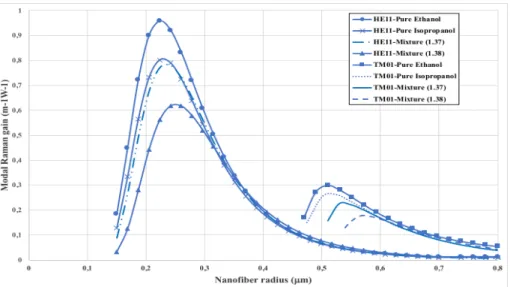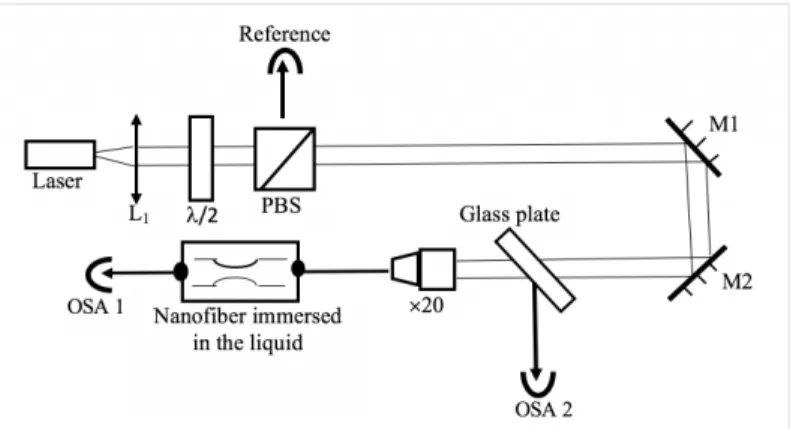HAL Id: hal-01788147
https://hal.archives-ouvertes.fr/hal-01788147v2
Submitted on 29 Oct 2018HAL is a multi-disciplinary open access archive for the deposit and dissemination of sci-entific research documents, whether they are pub-lished or not. The documents may come from teaching and research institutions in France or abroad, or from public or private research centers.
L’archive ouverte pluridisciplinaire HAL, est destinée au dépôt et à la diffusion de documents scientifiques de niveau recherche, publiés ou non, émanant des établissements d’enseignement et de recherche français ou étrangers, des laboratoires publics ou privés.
Optical characterization of a nanofiber immersed in a
Raman liquid
Maha Bouhadida, Abderrahim Azzoune, Philippe Delaye, Nicolas Dubreuil,
Gilles Pauliat, Sylvie Lebrun
To cite this version:
Maha Bouhadida, Abderrahim Azzoune, Philippe Delaye, Nicolas Dubreuil, Gilles Pauliat, et al.. Optical characterization of a nanofiber immersed in a Raman liquid. International Conference Optics and Photonics Algeria OPAL2018, May 2018, Oran, Algeria. pp. 48,50. �hal-01788147v2�
Optical characterization of a nanofiber immersed in a
Raman liquid
Maha Bouhadida, Abderrahim Azzoune, Philippe Delaye, Nicolas Dubreuil, Gilles Pauliat, Sylvie Lebrun
Laboratoire Charles Fabry, Institut d’Optique, CNRS, Université Paris-Saclay, 91127 Palaiseau cedex, France maha.bouhadida@institutoptique.fr
Abstract: Nanofibers are nowadays attracting attention as an interesting tool to explore evanescent nonlinearities. In this context, we propose a full optical characterization of a nanofiber immersed in a Raman liquid in order to control the backward Raman and Brillouin beams that limit the forward Raman effect. Simulations are performed determining the parameters of the nanofibers to be fabricated on this issue for different vectorial modes. An experimental setup is presented enabling us to investigate such a characterization. Further experimental results will be gotten and are expected to lead to novel applications in nonlinear optics.
Keywords: Nanofiber, evanescent nonlinearity, Raman effect, Brillouin effect
1. Introduction:
Optical fiber systems are the corner stone of the telecommunication infrastructure. They have steadily improved for several decades to become the best in overcoming the problem of increased society information demand. One of the novel ways exploiting them is to produce nanofibers. Nanofibers are tapered from standard silica fibers until reaching a diameter comparable or even smaller than the light wavelength. At such small diameters a strong confinement of light is obtained as well as an intense evanescent field useful for a lot of applications such as sensors, atomic traps or nonlinear optics exploration. We recently demonstrated “evanescent” stimulated Raman scattering in a few cm length nanofibers immersed in different liquids using subnanosecond pump pulses at 532 nm [1]. In this paper, we propose to go further by characterizing the nonlinear effects in competition with the evanescent Raman scattering. Since the pump pulse length has the same order of magnitude than the nanofiber length (≈10 cm), backward Raman and Brillouin scatterings are expected [2], limiting the efficiency of the forward Raman beam.
Then, we dedicate the first section for simulations of the modal Raman gain in order to determine the nanofiber dimensions (radius and length) needed for the nonlinear characterization. Different vectorial modes are studied and some immersing liquids are tested. The second section will detail the experimental setup.
2. Simulation part
The simulations are performed at a 532nm pump wavelength. When considering very small fiber diameters, the longitudinal components of the fields are not negligible compared to the transverse ones and so vectorial modes are the ones to be studied [3]. We were based on the expression below that presents the modal Raman gain depending on respectively the electric and magnetic fields e and h of the pump p and of the Stokes s:
e0 and c are the dielectric permittivity and the light celerity in vacuum; gR is the Raman coefficient expressed in mW-1 [3]. Since the numerator integral is calculated for the active area, n should be the immersing liquid index.
The modal Raman gain is calculated as a function of the nanofiber radius for different liquids. We consider that both pump and Stokes beams are propagating on the same mode, HE11 or TM01. For crossed interactions (HE11 – TM01), the modal Raman gain is very weak because of the small overlap between the fields. Other interactions with modes HE21 and TE01 have also been studied and present almost the same modal Raman gain as for the TM01 mode. We choose to use nontoxic liquids as ethanol and isopropanol, even if their Raman gain is quite low. A mixture of ethanol and DiMethyl SulfOxide
!",$= &' )* ∬123456 1761!, -*./". /$. * 89 ∬3@31A 1761:/"× ℎ"=. >̂ 89 ∬3@31A 1761(/$× ℎ$). >̂ 89 (1)
(DMSO) whose refractive index is 1.477 is also tested with an intermediate Raman coefficient. Since the DMSO fraction is relatively weak, ethanol remains the Raman active liquid. Their characteristics of the liquids are detailed in Tab. 1.
Liquid Raman shift
(cm-1) 1 st Stokes-ls (nm) Refractive index g R estimated at 532nm (Wm-1) Pure ethanol 2928 630 1.361 2.92 x 10-12 91% ethanol/9% DMSO 2928 630 1.37 2.65 x 10-12 83% ethanol/17% DMSO 2928 630 1.38 2.42 x 10-12 Pure isopropanol 819 556 1.378 2.5 x 10-12
Tab. 1. Immersing liquids data useful for simulations. As an approximation, the refractive index at pump and Stokes wavelengths are taken equal.
The variation of the modal Raman gain with the nanofiber radius is shown in Fig.1. We observe that there is an optimal radius for each plot. When the radius is smaller than this optimum, the beam can be considered as a plane wave spreading along important distances and so, the amplitude of the evanescent field decreases reducing the gain. However, larger radii make the mode more confined in the fiber core and so, the Raman gain decreases.
Fig. 1. Raman modal gain as a function of nanofiber radius
In our previous work, the radius of the nanofiber immersed in ethanol was close to the optimum radius of 0.22 µm. Such nanofibers were not easily pulled and manipulated. We are at present looking for alternative solutions to increase the optimum radius of the nanofiber keeping a high Raman gain, firstly to manipulate them more easily and secondly to move away from the laser damage threshold silica nanofibers (estimated from [1] to be around 140J/cm²). We notice that the optimum radius doesn’t increase significantly with the liquid index. For the HE11 mode, it goes from 0.22 µm for pure ethanol to only 0.25 µm for the mixture, accompanied with a modal Raman gain decrease from 0.95m-1W-1 to 0.62 m-1W-1. Increasing the surrounding liquid index is not the most efficient way to increase the nanofiber optimum radius. A more drastic solution is to use TM01 mode, the optimum radius being about 0.5 µm while the maximal gain is 0.3 m-1W-1.
In order to estimate the suitable nanofiber length, we introduce the critical parameter g=gRmodal´L´Pin where gRmodal is the modal Raman gain; L is the nanofiber length and Pin is the input pump power for which the output pump power is equal to the Stokes output power. By assuming a sub-nanosecond-pulsed regime at 532 nm, this critical parameter is evaluated to be 20 [1]. We consider a peak power of 1 kW in order to stay below the silica damage threshold. Then, we compute L in order to reach g=20. Considering pure ethanol, at the maximal modal Raman gain of 0.95 m-1W-1,
the
nanofiber radius is 0.22 µm and the length is about 2 cm. When we shift towards a radius of 0.35 µm, i. e. a radius that is now more straightforward to manipulate, we still have a modal Raman gain of 0.3 m-1W-1 and the nanofiber length is 6.5 cm which is feasible with our pulling process. From this radius, the three plotscannot be distinguished, and it will be interesting to investigate the performances of liquids differing by their Brillouin gain.
For the TM01-pure ethanol plot, we can see that a modal Raman gain of 0.3 m-1W-1 is obtained with a radius of 0.5 µm and a length of 6.5 cm. This relatively important radius enables the use of higher peak power while remaining under the silica damage threshold.
3. Experimental part
Fig. 2. shows a diagram of the experimental setup that enables us to investigate a full nonlinear characterization for a nanofiber over the fundamental mode HE11. A pulsed pump laser (from HORUS) emits a beamat 532 nm with a maximum available peak pump power of 7 kW, a pulse duration of 900 ps and a frequency rate repetition of 4.7 kHz. A lens L1 with a focal distance of 10cm collimates the pump light and the association of a half plate and a polarizing beam splitter help us to control the incident pump power since the laser is linearly polarized. Part of the pump beam is then reflected by the two mirrors M1 and M2 to pass through a glass plate. The nanofiber is pulled from a fiber that is single mode at both pump and Stokes wavelength (ref. 460HP from Thorlabs). After being fabricated with our pulling system [4], the nanofiber part is immersed in a tank filled with the Raman liquid. The pump beam is injected by a microscope objective (x20, NA 0.35), in the untapered input end of the fiber, propagates in the nanofiber and is collected at the output end of the fiber. The role of the glass plate is to reflect the backward beams into the optical spectrum analyzer OSA 2 while the OSA 1 will analyze the forward beams.
Fig. 2. Experimental setup for nanofiber nonlinear characterization over HE11
This experimental scheme will have to be adapted for TM01 pumping. Being inspired by [5], a new fiber has been identified and a special taper has already been designed to control its propagation.
4. Conclusion
Through this paper we determine the parameters of the nanofiber to be pulled (diameter and length) enabling an evanescent Raman conversion that satisfies the critical parameter for different vectorial modes and different liquids. We also present an appropriate experimental setup for an optical characterization of the nanofiber immersed in a Raman liquid, as backwards nonlinear effects are expected. The experimental results with pumping on the HE11 mode using different liquids and radii will be presented at the conference. Pumping on the TM01 mode is more challenging because we need to fabricate and to control the mode along the taper. It will open the way to new opportunities in nonlinear optics, such as modal phase matching.
This work is supported by the French National Research Agency (ANR) (FUNFILM-ANR-16-CE24-0010-03).
5. References
[1] Liye Shan et al., Applied Physics Letters, 102, 20 (2013).
[2] Min Châu Phan Huy et al., J. Europ. Opt. Soc. Rap. Public., 13031 (2017). [3] Mark D. Turner et al., OSA,19, 14 (2009).
[4] Liye Shan et al., J. Europ. Opt. Soc. Rap. Public., 13030 (2013). [5] Ravets, al., Optics Express, 21, 15 (2013).

